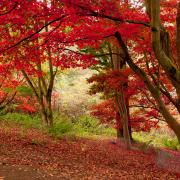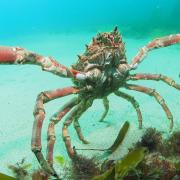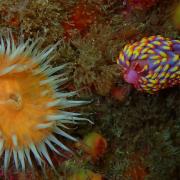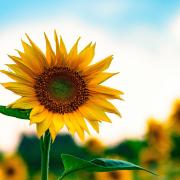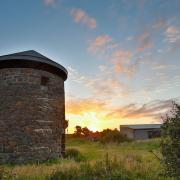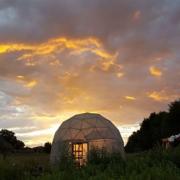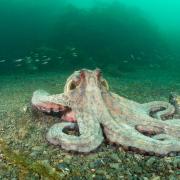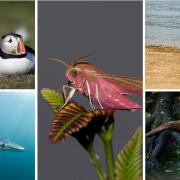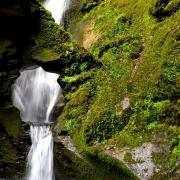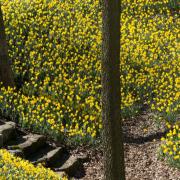In this August Issue we look at the sparrow's long association with humans
David Chapman looks at the sparrow's long association with humans
Sparrows are known for being a little drab in colour but colourful in behaviour. Sociable creatures, they even have a reputation for being a little promiscuous. In Cornwall we usually have just one breeding species of sparrow but we are also visited occasionally by another and, strangely, there is a common type of bird which is known as a sparrow but which most definitely is not!
HOUSE SPARROW (Passer domesticus)
Passer domesticus, literally sparrow of the house, has a long association with humans. Through its own volition, the house sparrow lives alongside us, taking benefit from the close association, but we too have much to gain from our (usually uninvited) house guests.
The house sparrow likes to nest under cover and has a reputation for making its home in our roof spaces, gaining entrance through holes under the eaves. They also nest in barns and outhouses. Their nests are often made from a variety of materials but always at the top of the list is grass or straw. They also use hair and even man-made products to create their rather scruffy nests, and occasionally they adopt nests left by other birds such as swallows.
In mid-summer, sparrows, like the rest of us, get a little over-heated and they often take to the pond for a dip. As with other activities they usually bathe in large groups and have a good splash around. They also dust-bathe, lying down in dry, sandy soil, fluttering their wings to cover themselves in dust. It is thought that this activity helps them to remove parasites from their feathers.
Sparrows can look a little drab when they moult in the autumn but, ironically, it is when their feathers begin to deteriorate in the spring that the black bibs and chestnut tones of the male's plumage shows through. The bib is the male's badge of masculinity; the bigger it is the more likely he is to find a mate. The fact that sparrows mate in the open led to the belief that they had many sexual partners. In fact, it has been found that their level of promiscuity is about the same as our own!
This isn't the only trait which the house sparrow shares with us. Just as we usually live in close proximity to others of our kind, so do house sparrows. Taking the comparison with humans one stage further, sparrows even have arguments with their neighbours, but unlike ours their arguments are entertaining.
Sparrows have benefited from our generous nature. Where we put out food for birds they will readily accept our kind invitation... though they don't always wait for an invite. Grain that we put out for chickens is a useful supplement to a sparrow's diet and they are also partial to cake crumbs! They have many traits which endear them to us; a garden simply wouldn't be the same without the chirruping of a sparrow, preferably a flock of them, in the background.
Sadly, house sparrows are currently suffering a serious decline throughout Britain. Over the last 25 years their number has almost halved, but this decline is more marked in urban areas. One key reason must be a lack of suitable nest sites as modern houses simply do not have the same nooks and crannies under the eaves as older ones.
If you don't have house sparrows living with you but you would like to encourage them, then there are just two things to do: first, hang up a seed feeder, and second, erect some nest boxes beneath the eaves. These boxes should have a hole with a diameter of about 11Ú2 inches, but there must be at least two or three of them because sparrows are naturally gregarious and nest in colonies.
TREE SPARROW (Passer montanus)
The only other true species of sparrow that you might come across in Cornwall is the tree sparrow, but an encounter with this species in the county is extremely unlikely. Tree sparrows have occasionally bred in Cornwall but never reliably. The best times to see them are during periods of migration when birds from other counties spread out looking for new breeding areas. This migratory occurrence is reflected in the best locations to spot them, which tend to be around the coast, particularly in the far west of the county.
The tree sparrow has a similar build to the house sparrow, if a little smaller. Like its more common cousin, the tree sparrow occurs in flocks, being a sociable creature, but it is more likely to be seen on farmland. In terms of its plumage, the tree sparrow is quite different to the house sparrow. It has a chestnut or even maroon head and a black spot on the cheeks. While the male and female house sparrows are very different in appearance, tree sparrows all look the same.
HEDGE SPARROW (Prunella modularis)
To complete the set of sparrows, the hedge sparrow is more appropriately known as the dunnock because this bird isn't actually a member of the sparrow family! I suspect it was first called a sparrow simply because it is small and brown like a female house sparrow. The 'hedge' was added to its name because the dunnock is often found looking for food underneath hedges. Look closely at the dunnock and you will notice that it has a slender bill, more similar to that of a robin than a sparrow. In fact, the dunnock is a member of the 'accentors', of which we don't have any other representatives in Britain. Recently the dunnock has become known, more accurately, as the 'hedge accentor'.
The dunnock is fairly common across the county and regularly visits gardens to find food. It is quite shy and often skulks, so it isn't often observed by people. The only time a dunnock will draw attention to itself is when it sings to establish its territory; its song is not as clear and beautiful as the robin's, but it does have a distinctive quality which can sometimes be described as enthusiastic but hardly ever tuneful!
Probably the most interesting behavioural aspect of the dunnock's year occurs during spring when male birds can often be seen pecking at the rear end of females. This strange habit is a precursor to mating and the aim of the male is to remove any sperm of its competitors before introducing his own.







